The American Go E-Journal is covering the 29th annual World Amateur Go Championship this week in Tokyo, Japan. Top amateurs from 68 countries are competing in the 8-round tournament. Watch the AGA website for real-time updates – including event reports, photos and game records – as well as special WAGC editions of the EJ this week. Unless otherwise noted, all reporting is by EJ Managing Editor Chris Garlock and photographs are by John
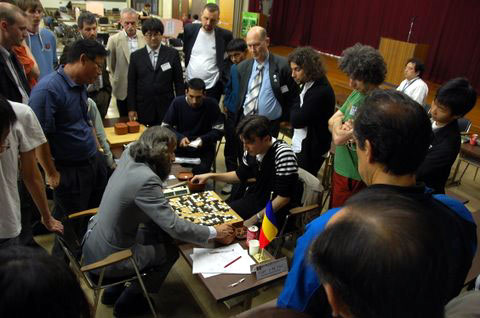 Pinkerton.
Pinkerton.FIELD NARROWS AT WAGC: As the World Amateur Go Championship hits the midpoint, the field is beginning to shake out. Among the top seeds, only Yuzheng Guo of China, Sung Bong Ha of Korea and Jan Hora of the Czech Republic are undefeated after four rounds. Also undefeated are 14th-ranked Fernando Aguilar (l) of Argentina – who squeaked out a dramatic 4th-round 2.5-point upset of 4th-ranked Cornel Burzo (r) of Romania – and 16th-ranked Laurent Heiser of Luxembourg. Third–seeded Yoshiyuki Tsuchimune of Japan lost in the 4th round to Korea, while 8th-ranked Mozhen Guan of the US lost in the third round to Argentina’s Fernando Aguilar. Guan defeated Zaid Zulkifli of Malaysia in the 4th round for a 3-1 record so far, with four more rounds to go. Cuba is one of the unlikely success stories, with 32nd-ranked Antonio Caballero following up his Wednesday upset of 7th-ranked Netherlands with a win over 30th-ranked Mexico and only losing to 10th-ranked Russia in the 3rd round. Click here for
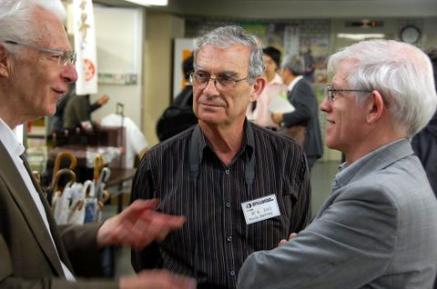 complete
results and game
records. Click here for an online album of photos from Day
1 at the WAGC
complete
results and game
records. Click here for an online album of photos from Day
1 at the WAGC - reported by Jeremy Banzhaf
FAMOUS GO WRITERS VISIT: Richard Bozulich (l), legendary go author and publisher dropped by the WAGC Thursday afternoon for a visit, along with equally notable go writer John Power (r). The white-haired duo – who are by far the most prolific go writers in English -- are still going strong, with Power planning to resume his regular go news column for the Nihon Ki-in website and Bozulich working on a couple of new books, including one on how to fight like a pro and the other on moyos. “’Fight Like A Pro, Secrets of Kiai’ shows how to resist and fight back, and not do what your opponent wants,” Bozulich told the E-Journal. “The book on moyo
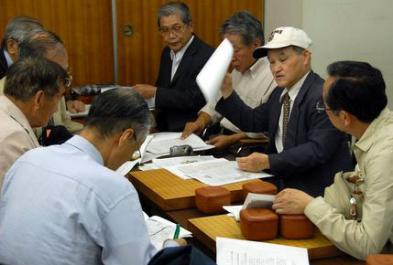 shows
how to build territorial frameworks, as well as how to invade, reduce
and defend them, with lots of examples from pro games.”
Bozulich expects both to be out next year. Also
in photo (center): Neville Smythe, Australian Go Association President.
shows
how to build territorial frameworks, as well as how to invade, reduce
and defend them, with lots of examples from pro games.”
Bozulich expects both to be out next year. Also
in photo (center): Neville Smythe, Australian Go Association President.HYODO SHUNICHI TO VISIT NYC: Hyodo Shunichi 6d (r, in cap) tells the E-Journal that he’ll be visiting the New York Go Center this fall for three months as an instructor for the Nihon Kiin. The enthusiastic go organizer and teacher has been leading Japanese tour groups to the U.S. Go Congress for many years – he already has 19 signed up for Portland – and served as tour guide and fellow go adventurer during EJ Managing Editor Chris Garlock’s first trip to Japan a few years ago. “I’m looking forward to both the Go Congress and my visit to New York,” Shunichi told the EJ. photo: Shunichi meets with '08 Congress tour group members Thursday at Nihon Ki-in to plan trip
WMSG DOMINATES IGF MEETING: Plans for this October’s World Mind Sports Games in Beijing dominated this week’s meeting of the International Go Federation (IGF) in Tokyo. The American Go Association’s Thomas Hsiang, who serves as a Director on the IGF – and was re-elected Monday along with the other six directors -- has been deeply involved in this
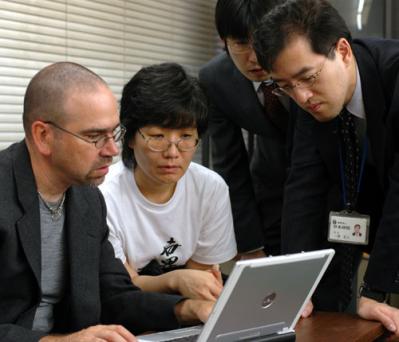 and
other top IGF priorities. The IGF helps promote go worldwide.
China’s recent disaster was also very much on
attendees’ minds and Monday’s meeting opened with a
long moment of silent prayer for the earthquake victims. In addition to
welcoming the WAGC representative from the Philippines -- which
rejoined the IGF last year – the body elected Korsak
Chairasmisak, President of the Thai Go Association, as an IGF Director.
IGF Secretary-General Yuki Shigeno reported on the extensive plans
underway for the first-ever World Mind Sports Games, which has been a
long-term goal of the IGF and the International Mind Sports Association
(IMSA). More than 650 players from 60 countries -- including many top
professionals – are now expected to participate. Thomas
Hsiang reported on a rules conference last month in Beijing, the
results of which will son be posted on the IGF website. Before a single
stone has been played at the 2008 WMSG, the IGF is working to get the
event included in future Olympics. Current plans call for applying to
the International Olympic Committee (IOC) in 2009, which will require
some organizational adjustments, including adoption and implementation
of anti-doping regulations. Hsiang noted that the IGF has no plans to
implement testing at this year’s WMSG event and the first
application of this will likely be at the 2009 World Amateur Go
Championships. In other actions, the IGF accepted Macau as the latest
IGF member, noted the formation – and IGF support for -- the
World Pair Go Association and regretfully reported the nonparticipation
again this year of DPR Korea in the WAGC, express
and
other top IGF priorities. The IGF helps promote go worldwide.
China’s recent disaster was also very much on
attendees’ minds and Monday’s meeting opened with a
long moment of silent prayer for the earthquake victims. In addition to
welcoming the WAGC representative from the Philippines -- which
rejoined the IGF last year – the body elected Korsak
Chairasmisak, President of the Thai Go Association, as an IGF Director.
IGF Secretary-General Yuki Shigeno reported on the extensive plans
underway for the first-ever World Mind Sports Games, which has been a
long-term goal of the IGF and the International Mind Sports Association
(IMSA). More than 650 players from 60 countries -- including many top
professionals – are now expected to participate. Thomas
Hsiang reported on a rules conference last month in Beijing, the
results of which will son be posted on the IGF website. Before a single
stone has been played at the 2008 WMSG, the IGF is working to get the
event included in future Olympics. Current plans call for applying to
the International Olympic Committee (IOC) in 2009, which will require
some organizational adjustments, including adoption and implementation
of anti-doping regulations. Hsiang noted that the IGF has no plans to
implement testing at this year’s WMSG event and the first
application of this will likely be at the 2009 World Amateur Go
Championships. In other actions, the IGF accepted Macau as the latest
IGF member, noted the formation – and IGF support for -- the
World Pair Go Association and regretfully reported the nonparticipation
again this year of DPR Korea in the WAGC, express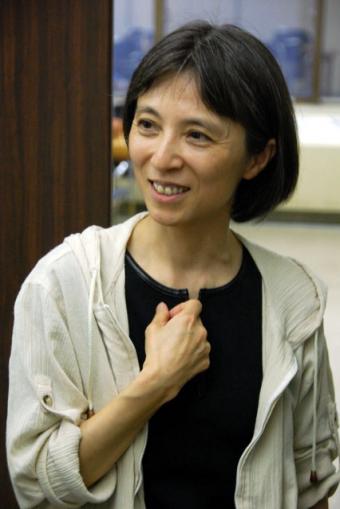 ing the
hope that the situation will be resolved by next year “so
that all IGF members can participate in the 30th annual
event.” Photo: IGF
Secretary-General Yuki Shigeno (center) and Nihon Kiin staff with EJ
Editor Chris Garlock.
ing the
hope that the situation will be resolved by next year “so
that all IGF members can participate in the 30th annual
event.” Photo: IGF
Secretary-General Yuki Shigeno (center) and Nihon Kiin staff with EJ
Editor Chris Garlock. “LET’S PLAY GO!” An Interview With Hikaru No Go Author Yumi Hotta
When Yumi Hotta (l) was learning to play go, she got frustrated at never being able to beat the professionals who taught her. “So I thought, Wouldn’t it be great if I had a strong supernatural ally, maybe then I could beat a pro someday,” she told the E-Journal late Tuesday afternoon at the Nihon Kiin in Tokyo. The result was the best-selling manga and anime series Hikaru no Go, which is credited with renewing or sparking interest in go worldwide in recent years. “I had no idea how popular it was outside Japan until I went to the European Go Congress two years ago and met so many people who told me they learned about go through Hikaru No Go,” Hotta said, laughing. Petite and watchful, Hotta radiates a quiet calm, her movements precise and each word carefully chosen. These days, she says, she and her husband Kiyonari Hotta, a fellow mangaka (manga writer) who also worked on HNG with her, live quietly at home with two bunchos, Japanese rice birds they’re raising. “The game of go is still very interesting,” Hotta said, “and I want to keep playing,” though she now prefers the turn-based version, and says that “some of my opponents are from America.” Chuckling, she said that “The problem is that Japanese and Americans who learn go from Hikaru No Go quickly become much stronger than me.” Interestingly, Hotta told the EJ “I never intended to teach go through the manga. It’s very hard to teach a person to play
- Special thanks to James Davies for translation/interpretation assistance.
THE TRAVELING BOARD: At The Igo Salon Dogenzaka
by Chris Garlock
Emerging from one of Tokyo's busiest railway stations into the mad hustle and bustle of Shibuya , it’s immediately obvious from the thousands of highly stylish youngsters there to shop, see and be seen that you’re in one of Japan’s fashion centers. It’s also where you find the famous statue of Hachiko, the Akita dog who waited faithfully at the station every night, even after his master died. Around the corner and up the street is the Igo Salon Dogenzaka, where Michael Simon 5d plays. Simon has long been active in the American go community, especially on the New York City scene and is a former Treasurer of the American Go Association. He and his wife Kanako moved to Tokyo last December and while Michael – whose resume includes everything from rock and roll musician to computer programmer, high-end car mechanic, real estate, wine importer and patents – is considering where to next apply his talents, he keeps his go game sharp at the Igo Salon. Hikaru No Go fans would recognize the club in an instant, as it was featured in #8 and not only does the club – with its bar running along a side wall and the rows of wooden name cards lining the front walls -- look just as it does in HNG, some of the players themselves are recognizable. “Let me introduce you to some of the thugs,” Michael (at right in photo, showing HNG #8 with the club manager) says affectionately during a visit last Sunday afternoon.
- photos by John Pinkerton. Click here for more photos.
Published by the American Go Association
Managing Editor: Chris Garlock
Assistant Editor: Bill Cobb
Professionals: Yilun Yang 7P; Alexandr Dinerchtein 3P; Fan Hui 2P
Contributors: Paul Barchilon (Youth Editor); Lawrence Ku (U.S. West Coast Reporter); Brian Allen (U.S. West Coast Photo Editor); Peter Dijkema (Dutch/European Correspondent); Marilena Bara (Romania/European Correspondent); Ian Davis (Ireland Correspondent)
Columnists: James Kerwin 1P; Kazunari Furuyama; Rob van Zeijst; Roy Laird; Peter Shotwell
Translations: Chris Donner (Japan); Bob McGuigan (Japan); Matt Luce (China)
Text material published in the AMERICAN GO E JOURNAL may be reproduced by any recipient: please credit the AGEJ -- and the author, contributor or photographer -- as the source. PLEASE NOTE that commented game record files MAY NOT BE published, re-distributed, or made available on the web without the explicit written permission of the Editor of the E-Journal. Please direct inquiries to journal@usgo.org
Articles appearing in the E-Journal represent the opinions of the authors and do not necessarily reflect the official views of the American Go Association.